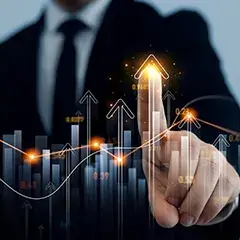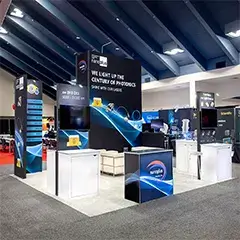
Your Guide to In-booth Technology
Ideas to utilize tech to drive results rather than gimmicks
 Let’s talk in-booth technology
Let’s talk in-booth technology
A wide range of industries are leveraging it. Attendees are expecting it. How onboard are you?
This guide aims to get you confidently onboard! After reading, you’ll know:
- The current landscape of technology usage in the exhibition industry
- How to leverage technology to both attract attendees and drive your marketing strategies
- Tips on developing the right type of in-booth technology for your target audience
- The various types of technologies currently being utilized
The Current Landscape of Technology in the Exhibition Industry
Booths that are tech-equipped tend to grab and hold the attention of event attendees. Technology, then, provides yet another way to engage your prospects longer – a key goal for event managers. This gives you a tremendous advantage over your competitors.
In the latest Marketing Technology Survey published by Exhibitor Magazine, these statistics say it all:
- 96% of face-to-face marketing professionals report their organizations are currently using technology to enhance marketing efforts
- When asked which corporate objectives technology helped achieve, these were the top 3 answers: increased brand awareness, increased leads, increased booth traffic
- 68% thought technology has limitless potential, in the context of exhibit marketing
- 85% said the value and importance of technology as a marketing tool would increase in the coming year
- 90% said they anticipate the amount of money they spend on in-booth technology will increase in the following year
- 72% said the technologies they used met or exceeded initial objectives
What is driving these statistics? Attendee expectations that everything is digital and more interactive. It’s not just the overall market for technology that is growing – the size and functionality of the equipment are increasing as well. The demand for larger video walls, LED screens, and touchscreen technology is on the rise.
Leveraging Technology to Attract and Drive Your Marketing Strategies
In-booth technology can undoubtedly help organically attract attendees. If done right, you can enhance their experience, engage them on a deeper level, and make sure they remember you. You can also leverage technology to improve the efficiency and effectiveness of your marketing strategies, such as:
- pre-show planning
- lead management
- long-term relationship building
- generating brand awareness
- cementing marketing position
- generating buzz
The key is to have the tech be interactive to booth visitors and extend the reach of your staff. A ton of time and money can be spent planning and executing various tech integrations. Training booth staff on how the tech works and how to assist in the visitor’s interactions are vital in maximizing ROI.
Taken a step further, well-trained and motivated staff will help monitor activity and wait times. They can make the necessary improvements, so you get the most out of your investment.
 The Right Type of Tech for Your Booth
The Right Type of Tech for Your Booth
We live in a tech-savvy world, and attendee expectations for interactive in-booth tech are growing. How do you decide on what kind of tech to integrate into your booth design?
Consider your audience: First, consider the demographics and preferences of your audience. Pair your technology medium, tactics, and messages to them. For example, if your target audience is baby boomers in the science industry, they might prefer statistics and data presented in augmented reality (AR), instead of social media engagement.
Know your story: What story does the marketing team want to tell within the booth space? The story should always drive the technology, rather than the other way around.
Keep it simple: Just like any marketing messaging that is intended to persuade, the messaging and imagery included in your tech presentation should be kept simple. If the experience takes too long or is not user-friendly, your audience will likely lose interest and engagement will be lost.
Incentivize participation: Depending on your audience, merely having interactive technology won’t necessarily equate to participation. Most people will not complete a task without an incentive. Consider entering them in a raffle if they complete a digital survey or sit through a video lecture.
Get creative with your incentives – offer a preferred seat at a live demo or privy information on a cutting-edge product. You might not always need to have a cash prize or a tangible gift as an incentive.
Types of Technologies Being Utilized
Now for the fun stuff! Our marketing team scoured resources and put together this list of various types of technologies currently being used in booth designs across the trade show industry.
Touch technology: Maximize the success of your content being viewed by displaying it creatively. Giant smartphones, tablets embedded in kiosk workstations, and interactive screens are just a few ways to utilize touch technology to display your content.
With touch technology, visitors can interact with your content on their terms, effectively putting them in the driver’s seat. You are giving them control over the experience they receive, and you can collect their contact information effortlessly.
Displaying product demonstrations, slideshows, brand videos, product catalogs, app demonstrations, and customer reviews are just a few possibilities. No matter your industry, touch screen technology can benefit you.
Digital signage: Make your booth identifiable from a distance by replacing printed signage with dynamic digital signage. This can come in the form of large-scale video walls or internet-connected displays on LCD or LED monitors. Digital signage is not the newest technology, but it’s undoubtedly one of the least expensive and can easily replace costly printed brochures.
You can easily update and adapt the content loaded in from show to show with minimal maintenance. Also, consider moving your product catalog online and display them digitally. Some quick tips from the Digital Signage Experts Group:
- Since most people view digital signs from 7-10 feet away, use at least a 20-point font.
- Position your display in portrait mode, which can generate as much as 30% more attention and recall.
- Always include a call-to-action (CTA) on the screen, ideally time-sensitive and with an immediate reward.
- If looping slides, place the most critical messages on the first and last slide and have them stay up on the screen longer than the others.
- Individual sections of a sign are called zones. Limit to no more than three zones and do not have them competing. The zone with the most pertinent info should be the largest.
- Place digital signs as close to average head height as possible – this is the area where most passerby will focus their attention.
- The average dwell time in front of a digital sign runs 4-6 seconds. Perform a dry run with staffers to see if they can absorb the messaging in this span.
Video walls: An undeniably eye-catching usage of technology. Video walls allow you to display one seamless image, multiple images, and video across different panels. Content options are as vast as the potential to captivate.
Motion controlled technology (touchless interaction): The possibilities are endless with this tech. Set up a product demo with a gesture-controlled interface so visitors can flick their hand to start and stop the demo. Set up a motion-sensitive floor that generates content when people walk across. You can also have lighting shift as visitors walk around your booth. Motion controlled tech allows you to create a fully immersive experience.
Virtual reality (VR): This is a computer-generated simulation or a replacement of one’s environment. When a user puts on a headset, it blocks out your worldview and substitutes a digital world that is designed to fool your senses. VR can be set up as a sit-down encounter or a standing 360-degree experience where users can physically explore.
Creating VR content is becoming more accessible and is truly one of the most unique experiences you can offer at your booth. It allows you to educate your audience and entertain them as well. A quick example can be seen in this video.
Augmented reality (AR): Also known as mixed reality, AR is different than VR in the way that its primary purpose is not to cut out the real world and transport you to a new one. Instead, it is meant as an enhancement of your real world with virtual objects in it.
Basically, AR adds digital elements into an actual environment. Inside a booth, you could incorporate virtual notes to go along with a product demo or send users on a virtual scavenger hunt to find hidden objects or clues overlaid on your actual booth. A quick example of AR in a booth space can be seen in this video.
Video projection: Bypass the limitations of VR and harness the power of a crowd with video projection (also called projection mapping). This technology uses the 3D environment around you as a projection surface, basically turning anything you want into a screen. By manipulating lighting to distort, you can blur the lines between reality and fiction.
Conductive ink: Currently, this technology is most prevalent in the health-care, automotive, and solar-panel industries but really could be utilized by any industry.
Conductive ink is a liquid that allows a figure drawn with it to transmit electricity. The ink can be applied to traditional materials and effectively turn them into electronic devices! When activated (usually by touch), these materials might illuminate or play a song as seen in this video.
Social media: Leveraging the power of social media can help you generate buzz during and after the show. They take some planning but setting up a social media wall to direct social media discussion during the show is a fantastic option to look into.
The video wall will aggregate social media posts for a visually engaging presentation. A similar option is the social vending machine, which is an interactive kiosk that drives social interaction by encouraging attendees to post to the social media accounts in exchange for a prize.
Another strategy is to develop a social media campaign that reports on the developments and insights of the show – your booth and beyond. This is an excellent way to boost your follower base and contribute to the industry. Prospects who were not able to attend the show can interact with your content.
Mobile apps: Most trade show organizers will have a companion app where you can scan attendee badges. If you want a different approach, there are mobile apps that you can customize to match the look and feel of your brand.
These apps can then be loaded to your device to capture surveys, contact info, and even send out notifications to attendees about what is happening at your booth. Popular options include iCapture, iLeads, Harvest Your Data, and QuickTapSurvey.
Charging stations (rest stops): Perhaps the most common-place usage of technology is offering charging stations to attract attendees. Design the stations with your colors and logos for brand exposure.
While people wait for their devices to charge, they can use touch screens nearby to learn more about your company, products, and services at their own pace. Your rest stop can be as simple as a few stands or a dedicated lounge area with sofas, coffee tables, free Wi-Fi, drinks, and food.
Conclusion
We hope this guide boosted your confidence to integrate tech into your booth design. Look for new and creative ways to use tech to create a memorable experience at your booth.
But keep in mind that all the tech in the world can’t make up for the “human technology” of interacting with your audience one on one and building relationships based on trust. This is what leads to new business.
